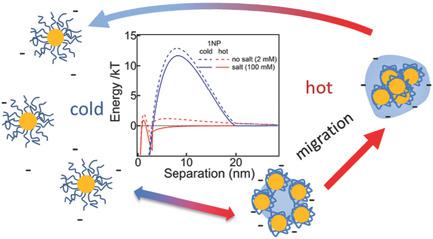当前位置:
X-MOL 学术
›
Adv. Opt. Mater.
›
论文详情
Our official English website, www.x-mol.net, welcomes your
feedback! (Note: you will need to create a separate account there.)
The Crucial Role of Charge in Thermoresponsive‐Polymer‐Assisted Reversible Dis/Assembly of Gold Nanoparticles
Advanced Optical Materials ( IF 8.0 ) Pub Date : 2018-02-22 , DOI: 10.1002/adom.201701270 Vladimir A. Turek 1 , Sean Cormier 1 , Benjamin Sierra-Martin 1 , Ulrich F. Keyser 1 , Tao Ding 1, 2 , Jeremy J. Baumberg 1
Advanced Optical Materials ( IF 8.0 ) Pub Date : 2018-02-22 , DOI: 10.1002/adom.201701270 Vladimir A. Turek 1 , Sean Cormier 1 , Benjamin Sierra-Martin 1 , Ulrich F. Keyser 1 , Tao Ding 1, 2 , Jeremy J. Baumberg 1
Affiliation

|
Dynamic control of the spacing between Au nanoparticles using nanoarchitectures incorporating the thermoresponsive polymer poly(N‐isopropylacrylamide) (PNIPAM) has the capability to induce strong color changes from the plasmon shifts. PNIPAM self‐assembles on the surface of Au nanoparticles regardless of its terminal group. However, in many cases, the collapse of this PNIPAM coating at elevated temperatures fails to cause a color change, due to electrostatic and steric repulsion between the Au nanoparticles. Here, it is shown how tuning the charge repulsion between the nanoparticles is crucial to achieve large, reversible shifts of the plasmon resonances. Using NH2 terminal groups of the PNIPAM is most effective, compared with SH, COOH, and H terminations, due to their synergistic role in citrate stripping and charge neutralization. This detailed understanding of the Au–PNIPAM system is vital to enable temperature‐responsive plasmonic systems with large tuning ranges, suitable for applications such as plasmonic actuators, displays, and Raman switches.
中文翻译:

电荷在金纳米颗粒的热响应性聚合物辅助可逆分解/组装中的关键作用
使用结合了热响应性聚合物聚(N-异丙基丙烯酰胺)(PNIPAM)的纳米结构,动态控制Au纳米粒子之间的间距具有诱导等离子体激元移位产生强烈颜色变化的能力。PNIPAM会在Au纳米颗粒的表面自组装,无论其端基如何。但是,在许多情况下,由于Au纳米粒子之间的静电和空间排斥,该PNIPAM涂层在高温下的崩塌无法引起颜色变化。在这里,显示了如何调节纳米粒子之间的电荷排斥力对于实现等离激元共振的大的可逆位移至关重要。使用 NH 2个的PNIPAM的末端基团是最有效的,比 SH,COOH和H端基,由于它们在柠檬酸盐汽提和电荷中和中具有协同作用。对Au–PNIPAM系统的详细了解对于启用具有大调谐范围的温度响应等离子体系统至关重要,适用于等离子体致动器,显示器和拉曼开关等应用。
更新日期:2018-02-22
中文翻译:

电荷在金纳米颗粒的热响应性聚合物辅助可逆分解/组装中的关键作用
使用结合了热响应性聚合物聚(N-异丙基丙烯酰胺)(PNIPAM)的纳米结构,动态控制Au纳米粒子之间的间距具有诱导等离子体激元移位产生强烈颜色变化的能力。PNIPAM会在Au纳米颗粒的表面自组装,无论其端基如何。但是,在许多情况下,由于Au纳米粒子之间的静电和空间排斥,该PNIPAM涂层在高温下的崩塌无法引起颜色变化。在这里,显示了如何调节纳米粒子之间的电荷排斥力对于实现等离激元共振的大的可逆位移至关重要。使用 NH 2个的PNIPAM的末端基团是最有效的,比 SH,COOH和H端基,由于它们在柠檬酸盐汽提和电荷中和中具有协同作用。对Au–PNIPAM系统的详细了解对于启用具有大调谐范围的温度响应等离子体系统至关重要,适用于等离子体致动器,显示器和拉曼开关等应用。











































 京公网安备 11010802027423号
京公网安备 11010802027423号